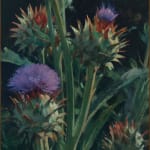Jacobus van Looy (1855-1930)
Jacobus Van Looy was born on 12 September 1855 in Haarlem as the son of a carpenter. His father lost his job when his eyesight began to fail. His mother died when he was five years old and when his father died soon afterwards he ended up in the local orphanage. He trained to become a house painter, but was able to follow drawing classes, from 1877 at the Rijksacademie van Beeldende Kunsten in Amsterdam. In 1884, Van Looy received the Prix de Rome, which allowed him to travel. The years 1885-1886 he spent traveling through Italy, Spain and Morocco. Until 1894 he lived in Amsterdam, when he married Titia van Gelder and moved to Soest. In 1901, he spent another year in Spain and Morocco. He moved back to Haarlem in 1913, when the orphanage where he grew up was converted into the Frans Hals Museum. He bought a house on the corner of the Haarlemmerhout Park, where he was often seen taking walks. After his death in 1930, this house was converted to a museum in his name, although it closed in 1976 and the collection was given on deposit to the Frans Hals Museum.
Although Van Looy started to paint his flowering gardens in different sizes around 1900, in 1914, he painted a small series of close ups of flowers, all on panels measuring around the same size. If they were originally intended as a series remains unclear. Four other flower paintings from the same year where framed together. Besides the present artichokes, Van Looy painted the flowers of cardamom, malvern and marigold, perhaps also to be kept together as a quadripartite but now dispersed.



